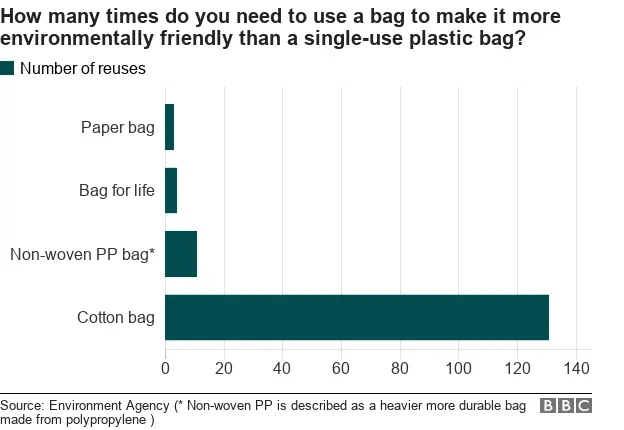Plastic or paper: Which bag is greener?
 PA
PAThe supermarket chain Morrisons is raising the price of its reusable plastic bags from 10p to 15p as a trial and introducing a 20p paper version. The paper bags will be available in eight stores as part of a two-month trial. The supermarket chain said reducing plastic was their customers' top environmental concern.
Paper bags remain popular in the US, but they fell out of use in UK supermarkets in the 1970s as plastic was seen as a more durable material.
But are paper bags more environmentally friendly than plastic ones?
The answer comes down to:
- how much energy is used to make the bag during manufacturing?
- how durable is the bag? (i.e. how many times can it be reused?)
- how easy is it to recycle?
- how quickly does it decompose if thrown away?
'Four times as much energy'
In 2011 a research paper produced by the Northern Ireland Assembly said it "takes more than four times as much energy to manufacture a paper bag as it does to manufacture a plastic bag."
Unlike plastic bags (which the report says are produced from the waste products of oil refining) paper requires forests to be cut down to produce the bags. The manufacturing process, according to the research, also produces a higher concentration of toxic chemicals compared with making single-use plastic bags.
Paper bags also weigh more than plastic; this means transportation requires more energy, adding to their carbon footprint, the study adds.
Morrisons says that the material used to make its paper bags will be 100% sourced from forests that are managed responsibly.
And if new forests are grown to replace lost trees, this will help to offset the climate change impact, because trees lock up carbon from the atmosphere.
In 2006, the Environment Agency examined a range of bags made from different materials to find out how many times they need to be reused in order to have a lower global warming potential than a conventional single-use plastic bag.

At the other end of the spectrum, the Environment Agency found that cotton bags required the most number of reuses, at 131. That was down to the high amount of energy used to produce and fertilise cotton yarn.
But even if a paper bag requires the fewest reuses there is a practical consideration: will it last long enough to survive at least three trips to the supermarket?
Paper bags are not as durable as bags for life, being more likely to split or tear, especially if they get wet.
In its conclusion, the Environment Agency says "it is unlikely the paper bag can be regularly reused the required number of times due to its low durability".
Morrisons insists there is no reason its paper bag cannot be reused as many times as the plastic one it is replacing, although it depends on how the bag is treated.
Cotton bags, despite being the most carbon intensive to manufacture, are the most durable and will have a much longer life.
Despite its low durability, one advantage of paper is that it decomposes much more quickly than plastic, and therefore it is less likely to be a source of litter and pose a risk to wildlife.
Paper is also more widely recyclable, while plastic bags can take between 400 and 1,000 years to decompose.
So what's best?
Paper bags require marginally fewer reuses than bags for life to make them more environmentally friendly than single-use plastic bags.
On the other hand, paper bags are less durable than other types of bags. So if customers have to replace their paper ones more frequently, it will have a greater environmental effect.
But the key to reducing the impact of all carrier bags - no matter what they are made of - is to reuse them as much as possible, says Margaret Bates, professor of sustainable waste management at Northampton University.
Many people forget to bring their reusable bags on their weekly supermarket trip, and end up having to buy more bags at the till, she says.
This will have a much bigger environmental impact compared with just choosing to use paper, plastic or cotton.



